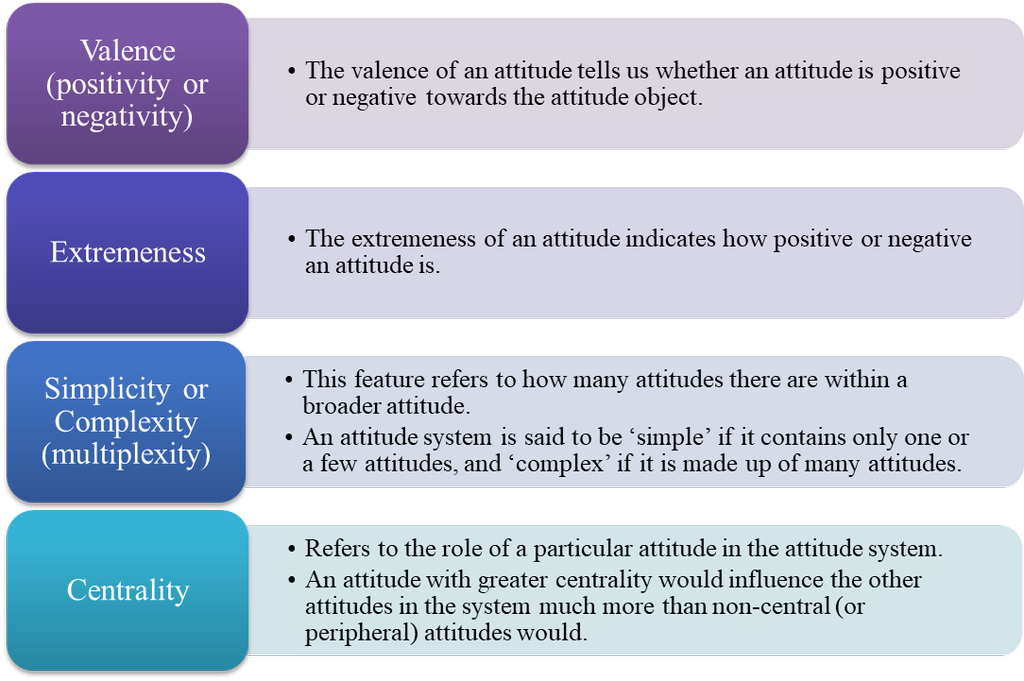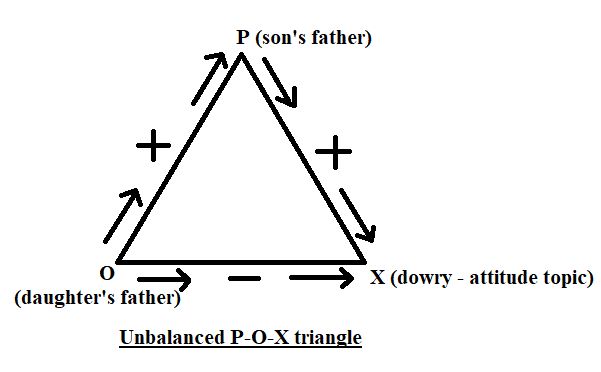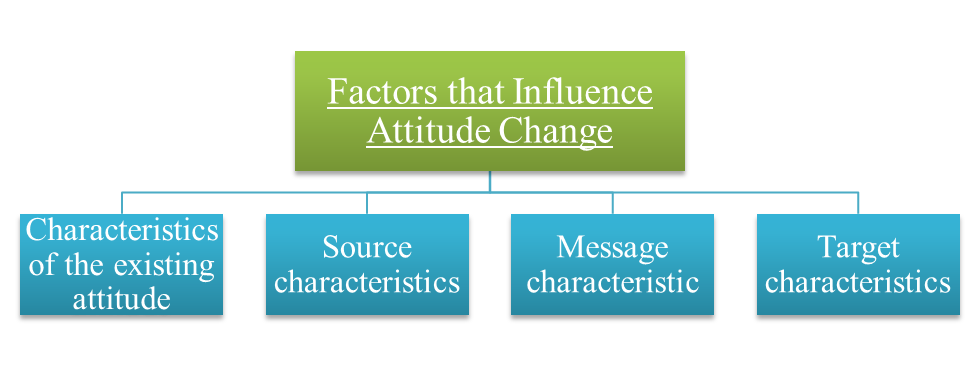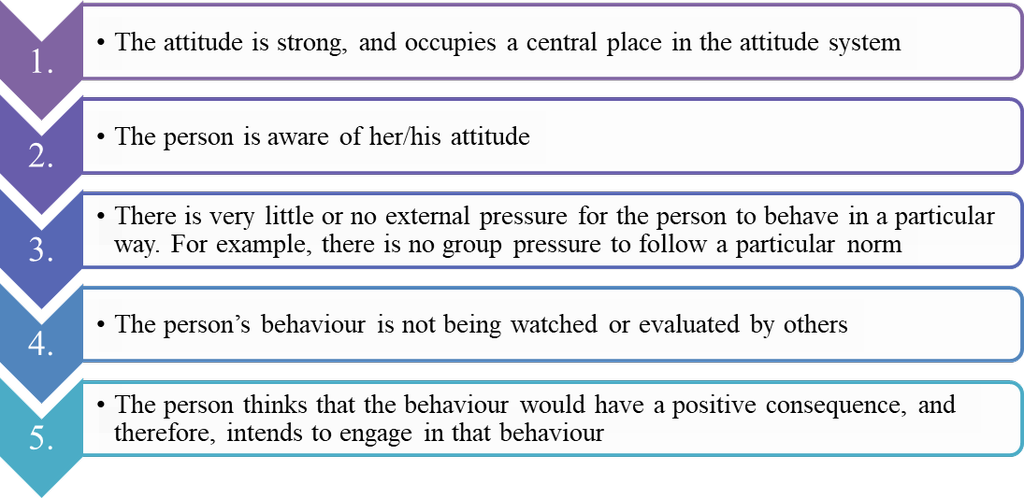- Books Name
- Psychology Book Class-12
- Publication
- PathSet Publications
- Course
- CBSE Class 12
- Subject
- Psychology
Nature and Components of Attitude
- Attitude is a state of the mind, a set of views, or thoughts, regarding some topic (called the ‘attitude object’), which have an evaluative feature (positive, negative or neutral quality), accompanied by an emotional component, and a tendency to act in a particular way with regard to the attitude object.
- Components of Attitude (A-B-C Components)
- Cognitive Aspect à Thought Component
- Affective Aspect à Emotional Component
- Behavioural (or conative) Aspect à The tendency to act
- For example,
- An individual has a positive view towards a ‘Green Environment’ and thus supports tree plantation drive. (Cognitive component)
- The individual feels very happy when he/she sees greenery and feels sad and angry when trees are cut down. (Affective component)
- The individual also actively participate in the tree plantation campaign. (Behavioural component).
- Attitudes are themselves not behaviour, but they represent a tendency to behave or act in certain ways.
- Attitudes are different from two other closely related concepts:
- Beliefs refer to the cognitive component of attitudes, and form the ground on which attitudes stand, such as belief in God, or belief in democracy as a political ideology.
- Values are attitudes or beliefs that contain a ‘should’ or ‘ought’ aspect, such as moral or ethical values. Example “one should work hard”
Values are formed when a particular belief or attitude becomes an inseparable part of the person’s outlook on life.
Consequently, values are difficult to change.
- Significant Features of Attitudes are:

- Purpose served by an Attitude
Attitudes provide a background that makes it easier for a person to decide how to act in new situations.
For example, our attitude towards foreigners may indirectly provide a mental ‘layout’ or ‘blueprint’ for the way in which we should behave whenever we meet one.
Attitude Formation
Attitudes are learned through one’s own experiences, and through interaction with others.

- Learning attitudes by association
- For instance, a positive attitude is developed/learned for a particular subject because of the positive association between a teacher and a student.
- Learning attitudes by being rewarded or punished
- If an individual is praised for showing a particular attitude, chances are high that s/he will develop that attitude further.
- On the other hand, if the individual is punished/scolded, then the person is likely to develop a negative attitude towards the attitude object which was responsible for the individual getting punished.
- Learning attitudes through modelling (observing others)
- We learn attitudes by observing others being rewarded or punished for expressing thoughts, or showing behaviour of a particular kind towards the attitude object.
- Learning attitudes through group or cultural norms
- We learn attitudes through the norms of our group or culture.
- Norms are unwritten rules about behaviour that everyone is supposed to show under specific circumstances.
- Over time, these norms may become part of our social cognition, in the form of attitudes.
- Learning attitudes through group or cultural norms may actually be an example of all three forms of learning described above — learning through association, reward or punishment, and modelling.
- Learning through exposure to information
- Many attitudes are learned in a social context, but not necessarily in the physical presence of others.
- Today, with the huge amount of information that is being provided through various media, both positive and negative attitudes are being formed.
Factors that Influence Attitude Formation

- Family and School Environment
- In the early years of life, parents and other family members play a significant role in shaping attitude formation.
- Later, the school environment becomes an important background for attitude formation.
- Learning of attitudes within the family and school usually takes place by association, through rewards and punishments, and through modelling.
- Reference Groups
- Reference groups indicate to an individual the norms regarding acceptable behaviour and ways of thinking.
- Thus, they reflect learning of attitudes through group or cultural norms.
- Attitudes towards various topics, such as political, religious and social groups, occupations, national and other issues are often developed through reference groups.
- Their influence is noticeable especially during the beginning of adolescence, at which time it is important for the individual to feel that s/he belongs to a group.
- Therefore, the role of reference groups in attitude formation may also be a case of learning through reward and punishment.
- Personal Experiences
- Many attitudes are formed, not in the family environment or through reference groups, but through direct personal experiences which bring about a drastic change in our attitude towards people and our own life.
- Media-related Influences
- Technological advances in recent times have made audio-visual media and the Internet very powerful sources of information that lead to attitude formation and change.
- School level textbooks also influence attitude formation.
- These sources first strengthen the cognitive and affective components of attitudes, and subsequently may also affect the behavioural component.
- The media can exert both good and bad influences on attitudes.
- On one hand, the media and Internet make people better informed than other modes of communication.
- On the other hand, there may be no check on the nature of information being gathered, and therefore no control over the attitudes that are being formed, or the direction of change in the existing attitudes.
- The media can be used to create consumerist attitudes where none existed, and can also be harnessed to create positive attitudes to facilitate social harmony.
Attitude Change
- Attitudes may be changed and modified through various influences.
- Attitudes that are still in the formative stage, and are more like opinions, are much more likely to change compared to attitudes that have become firmly established, and have become a part of the individual’s values.

- The concept of balance by Fritz Heider
- Described in the form of the ‘P-O-X’ triangle, which represents the relationships between three aspects or components of the attitude.
- P is the person whose attitude is being studied
- O is another person
- X is the topic towards which the attitude is being studied (attitude object)
It is also possible that all three are persons.
- The basic idea is that an attitude changes if there is a state of imbalance between the P-O attitude, O-X attitude, and P-X attitude, because imbalance is logically uncomfortable. Therefore, the attitude changes in the direction of balance.
- Imbalance is found when:
- all three sides of the P-O-X triangle are negative
- two sides are positive, and one side is negative.
- Balance is found when:
- all three sides are positive
- two sides are negative, and one side is positive
For example-

Therefore, one of the three attitudes will therefore have to change. This change could take place in either of the following:
- P-X relationship (P starts disliking dowry as a custom i.e. develop a negative attitude towards X)
- O-X relationship (O starts liking dowry as a custom i.e. develop a positive attitude towards X)
- O-P relationship (O starts disliking P i.e. develops a negative attitude towards P).
In short, an attitude change will have to take place so that there will be three positive relationships, or two negative and one positive relationship, in the triangle.
- The concept of cognitive dissonance by Leon Festinger
- Emphasises the cognitive component
- The basic idea is that the cognitive components of an attitude must be ‘consonant’ (opposite of ‘dissonant’), i.e., they should be logically in line with each other.
- If an individual finds that two cognitions in an attitude are dissonant, then one of them will be changed in the direction of consonance.
- For example,
Cognition I : Pan masala causes mouth cancer which is fatal.
Cognition II : I eat pan masala.
This shows dissonance in the attitude towards pan masala.
Therefore, one of these ideas will have to be changed, so that consonance can be attained.
Thus, in order to remove or reduce the dissonance, I will stop eating pan masala (change Cognition II). This would be the healthy, logical and sensible way of reducing dissonance.
- Both balance and cognitive dissonance are examples of cognitive consistency i.e. two components, aspects or elements of the attitude, or attitude system, must be in the same direction or should logically fall in line.
- If this does not happen, then the person experiences a kind of mental discomfort, i.e. the sense that ‘something is not quite right’ in the attitude system.
- In such a state, some aspect in the attitude system changes in the direction of consistency, because our cognitive system requires logical consistency.
- The two-step concept by S.M. Mohsin
- According to him, attitude change takes place in the form of two steps:
- In the first step, the target of change identifies with the source.
- The ‘target’ is the person whose attitude is to be changed.
- The ‘source’ is the person through whose influence the change is to take place.
- Identification means that the target has liking and regard for the source.
- S/he puts herself/himself in the place of the target, and tries to feel like her/him.
- The source must also have a positive attitude towards the target, and the regard and attraction becomes mutual.
- In the second step, the source herself/himself shows an attitude change, by actually changing her/him behaviour towards the attitude object.
- Observing the source’s changed attitude and behaviour, the target also shows an attitude change through behaviour.
- This is a kind of imitation or observational learning.
Factors that Influence Attitude Change

- Characteristics of the existing attitude
- All four properties of attitudes — valence (positivity or negativity), extremeness, simplicity or complexity (multiplexity), and centrality or significance of the attitude, determine attitude change.
- Valence: In general, positive attitudes are easier to change than negative attitudes are.
- Extremeness/Centrality: Extreme attitudes, and central attitudes are more difficult to change than the less extreme, and peripheral (less significant) attitudes are.
- Complexity: Simple attitudes are easier to change than multiple attitudes are.
- The direction and extent of attitude change are considered too. An attitude change may be congruent i.e. it may change in the same direction as the existing attitude. For example, a positive attitude may become more positive, or a negative attitude may become more negative.
- It has been found that, in general, congruent changes are easier to bring about than are the incongruent changes in attitude.
- Moreover, an attitude may change in the direction of the information that is presented, or in a direction opposite to that of the information presented.
- Research has found that fear sometimes works well in convincing people but if a message generates too much fear, it turns off the receiver and has little persuasive effect.
- Source characteristics
- Source credibility and attractiveness are two features that affect attitude change.
- Attitudes are more likely to change when the message comes from a highly credible source rather than from a low-credible source.
- Message characteristics
- Message is the information that is presented in order to bring about an attitude change.
- Attitudes will change when the amount of information that is given about the topic is just enough, neither too much nor too little.
- Whether the message contains a rational or an emotional appeal, also makes a difference.
- The motives activated by the message also determine attitude change.
- The mode of spreading the message plays a significant role.
- Face-to-face transmission of the message is usually more effective than indirect transmission, as for instance, through letters and pamphlets, or even through mass media.
- These days transmission through visual media such as television and the Internet are similar to face-to-face interaction, but not a substitute for the direct face-to-face transmission (physical presence).
- Target characteristics
- Qualities of the target, such as persuasibility, strong prejudices, self-esteem, and intelligence influence the likelihood and extent of attitude change.
- People, who have a more open and flexible personality, change more easily.
- People with strong prejudices are less prone to any attitude change than those who do not hold strong prejudices.
- Persons who have a low self-esteem, and do not have sufficient confidence in themselves, change their attitudes more easily than those who are high on self-esteem.
- More intelligent people may change their attitudes less easily than those with lower intelligence.
- However, sometimes more intelligent persons change their attitudes more willingly than less intelligent ones, because they base their attitude on more information and thinking.
Attitude-Behaviour Relationship
- Behaviour of an individual is usually expected to follow logically from attitudes.
However, an individual’s attitudes may not always be exhibited through behaviour.
Likewise, one’s actual behaviour may be contrary to one’s attitude towards a particular topic.
In other words, attitudes may not always predict actual pattern of one’s behaviour.
- Sometimes, it is behaviour that decides the attitude.
- There would be consistency between attitudes and behaviour when :


 PathSet Publications
PathSet Publications
